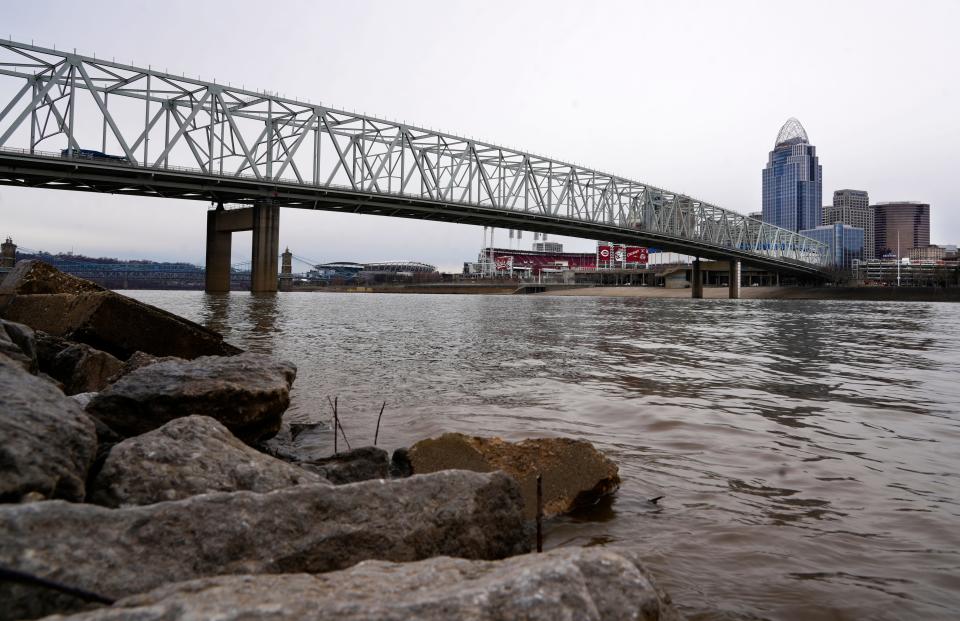Just Askin': Ohio River hasn't frozen over since 1977. What would it take to freeze again?
The Enquirer's Just Askin' series aims to answer the questions that no one seems to have an answer for, not even Google.
Cincinnatians who were around 47 years ago may remember a time when they could travel to Kentucky, no bridge required. And no, they didn't fly.
Instead, they donned their sturdiest boots – and some laced up their ice skates – to traverse straight across a frozen-solid Ohio River.
It was Jan. 19, 1977, the height of one of the harshest winters in recent memory. It was also the most recent time the Ohio River froze over. Ice was packed 8 to 12 inches thick along the length of the city when hundreds flocked to the riverfront to attempt the journey across.
And as bitter cold set in this week – and didn't go away – some wonder if we'll ever see one of the largest river basins east of the Mississippi River go solid again.
Between Jan. 14 and Friday, temperatures ranged from 4 to 27 degrees. Freezing temperatures will continue until Monday, when meteorologists forecast a high of 37 degrees.
The prolonged frigid conditions may pique the interest of thrill seekers wanting to roam the Ohio River on foot for the first time. Will their dreams be realized after seven days of freezing temperatures? Not likely, experts tell The Enquirer.
Enquirer Throwback: Frozen Ohio River
Under what conditions would the Ohio River freeze over again?
Cincinnati has had a week of freezing temperatures. That's not long enough, said Brian Coniglio, meteorologist with the National Weather Service at Wilmington.
"It would take weeks," Coniglio said. "It’s hard to get a smaller stream to freeze over, so it’s going to take a lot more this year for the river to freeze over."
River operations implemented in the 20th century made it more difficult for the waterway to completely freeze. Dams installed through the years forced the river wider and deeper, seldom going above 25 feet. Before 1936, the river stage at Cincinnati was often below five feet, the Enquirer reported on Jan. 13, 1977. On Thursday, the river depth was around 31 feet.
Higher depth and increased water flow didn't keep the river from solidifying during a few exceptionally cold winters, however. One year after the Marcum Dam was built in 1963 and increased its depth, the Ohio still froze over. Then again in the winters of 1976-1977 and 1977-1978.

What would happen with drinking water, commerce if the river froze over?
The Ohio River Navigation System enables 245 million tons of commodities to be shipped annually, moving 35% of the nation's waterborne commerce, according to the U.S. Corps of Army Engineers. Each year, more than 36.5 million tons of those commodities pass through Meldahl Locks and Dam, located upriver from Cincinnati.
The corps operates locks and dams on the river 24 hours a day, 365 days a year. Procedures depend on the district, but if a freeze-over occurs, the corps can flush ice through the lock chambers, similar to how it flushes debris. Air bubblers on the miter gates can clear debris and ice. Equipment is always kept moving so it doesn't freeze up.
The worst-case scenario for commerce? Steamboats and barges getting stuck in jagged ice floes, or even sinking. The winter of 1917-1918 was one of the worst on record when the Ohio River froze along its entire length. The ice gorge crushed and sank the Princess, one of the passenger steamboats to Coney Island.
Cincinnatians may also wonder where drinking water would come from if water stopped flowing on the Ohio. Fear not. Water intake points are way below the surface, designed to avoid the surface that could solidify under extensive cold conditions. Richard Harrison, executive director of the Ohio River Valley Water Sanitation Commission, said there are more issues at the surface.
"Utilities have challenges," Harrison said, like water main breaks or freezing pipes in homes. "That’s a challenge, but not so much from the river freezing."
Do you have a question for Just Askin'? Send it to us at cinlocalnews@enquirer.com.
This article originally appeared on Cincinnati Enquirer: Will the Ohio River freeze this week in Cincinnati?

